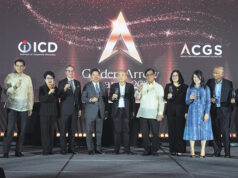Embarking on the endeavor of a lifetime
By Bjorn Biel M. Beltran, Special Features Writer
Andrew Carnegie is known worldwide as a titan industrialist, almost single-handedly leading America’s steel industry in the 1800s and becoming one of the richest people in history. He had laid the foundations for the US’ ascent to the global economic spotlight, after which he became one of the biggest philanthropists that the world has ever seen.
Benjamin O. Yao, SteelAsia’s chairman and chief executive officer, might not be Andrew Carnegie, but with him becoming the Philippines’ Entrepreneur of the Year for 2019, the comparison seems apt.
Under Mr. Yao, SteelAsia has become the Philippines’ flagship steel firm and among the largest rebar manufacturers in Asia. With presence across the archipelago, the company produces over two million metric tons annually, serving over 2,000 customers, including the country’s biggest property developers.
It all started when he was 17, a university student working part-time at his father’s steel business at the bottom rung of the corporate ladder.
“Steel has meant different things to me at different points in my life,” Mr. Yao told BusinessWorld in an exclusive interview.
“As a teenager working in the family business that my father founded, steel was a way to help my father succeed in what he believed in. This led me to shadow him, and as a result, absorb his values and his focus on the business.”
As a young man, Mr. Yao rose through the ranks, eventually becoming tasked with the management of the operations of the plant. It was here where he absorbed the tricks of the trade, from productivity, efficiency, movement and handling, cleanliness, and quality, to even the strategy of sustainability through technology and scale.
“Over the years, and with growth, I have seen the business transform to involve more stakeholders and to have a more significant national impact. The paradox of this is that the more we built the business, the less say we had in it,” he said.
The journey towards transforming SteelAsia into what it is today is hard-won. Throughout the years, the company had to maneuver challenges such as the Asian financial crisis, and raise the standards of a local steel industry that had grown complacent with profits from a high-tariff regime that burdened customers with high prices and poor quality.
“Even then, I believed that the country deserved better. I also believed that long-term viability was possible only with sound business fundamentals such as technology-based cost efficiencies,” Mr. Yao said.
Determined to offer better products to Filipinos, SteelAsia established the country’s first modern rebar mill in Bulacan in 1996, and from there it began expanding the steel industry outside of Metro Manila.
Through investments in technology, the company can change specifications quickly depending on its customers’ needs instead of managing stocks and double-handling rebars. Through setting up regional mills, the high shipping costs transporting steel from Manila to other parts of the country were effectively negated to allow customers to get the same quality of steel locally at the same price.
Regionalization also gave SteelAsia a platform for inclusive business as the local operations had a direct impact on communities. The company worked with the communities to develop and hire from within, and grow local suppliers and service providers such as truckers who have a long-term stake in the business.
By 2014, SteelAsia had built 2.3M tons capacity, and has established itself as the largest rebar producer in Southeast Asia and among the global leaders for rebar.
“Our decisions were merely addressing our responsibility to our market and our country. Our strategic and day-to-day actions are founded on the belief that the development of the Philippine steel industry is vital to the inclusive economic growth of our country,” Mr. Yao said.
“We celebrate our victories when awarded a supply contract, when customers show appreciation for our service, or when we commission a new mill and many others. You can call all these successes. Yet when we think of success, we think of achieving our dream of building a steel industry for the Philippines. We are driven by this, but we will never become complacent by thinking that we are successful.”
Already, Mr. Yao is setting his sights on the next phase of developing the Philippine steel industry. As part of an import substitution strategy, SteelAsia is working on projects that currently include a 1 million ton per year rebar mill in Cebu; the first beams, sheet piles and heavy angles manufacturing in Batangas; the first wire rod mill in Quezon; a recycling-based steelmaking facility in Davao; and the country’s first welded reinforcing mesh. These new plants will begin operating over a five-year period.
“The First World in the West began building their steel industries over a hundred years ago. Over the past 50 years, our Asian neighbors — Japan, Taiwan, Korea — started the same. And more recently, China and Vietnam,” Mr. Yao said.
He added, “The Philippines is only starting now. We are still so behind. Our economy is one of the few bright spots in the world. We are in the nascent stage of development, economy-wise and steel industry-wise. There is still decades of growth ahead.”
The Greeks once said that a society grows great when old men plant trees whose shade they know they shall never sit in. Like Andrew Carnegie, Mr. Yao seeks to set the foundation for the country’s growth, for a better future that he might never personally see.
“Steel is an endeavor of a lifetime — meant to last for generations. It has to grow and evolve according to the country’s needs, and opportunities to improve and innovate,” he said. “We want to build something enjoyed by generations down the road. In other words, it is a success we will never see in our lifetime.”


